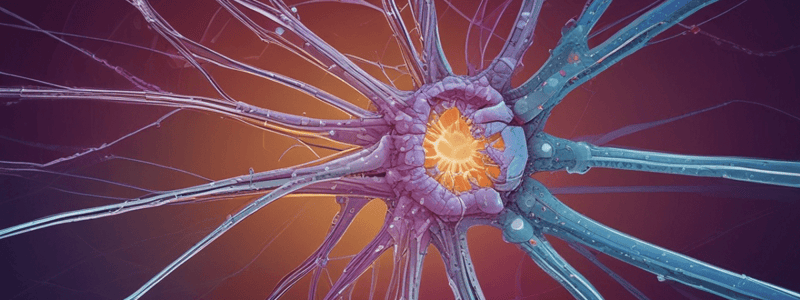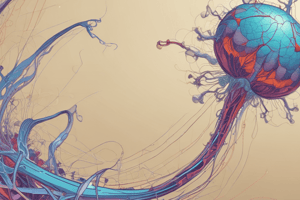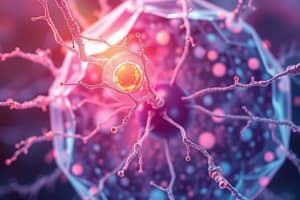Podcast
Questions and Answers
What is the main characteristic of intermediate filaments?
What is the main characteristic of intermediate filaments?
- Not dynamic, provides reinforcement and support (correct)
- Highly dynamic
- Rigid hollow rods
- Thin, flexible structures
What is the function of keratin filaments in epithelial cells?
What is the function of keratin filaments in epithelial cells?
- Provide structural support (correct)
- Form mitotic spindles
- Regulate cell shape
- Involved in intracellular transport
What is the result of mutations in keratin-5 and -14?
What is the result of mutations in keratin-5 and -14?
- Actin filament disorganization
- Epidermolysis Bullosa Simplex (correct)
- Microtubule instability
- Cytokinesis failure
What is the function of microtubules in cells?
What is the function of microtubules in cells?
What is the role of GTP in microtubule polymerization?
What is the role of GTP in microtubule polymerization?
What is the function of dynein in microtubules?
What is the function of dynein in microtubules?
What is the function of actin filaments in muscle cells?
What is the function of actin filaments in muscle cells?
What is the difference between G-actin and F-actin?
What is the difference between G-actin and F-actin?
What is the role of ATP in actin filament assembly?
What is the role of ATP in actin filament assembly?
What is the function of centrosomes in microtubules?
What is the function of centrosomes in microtubules?
What is the role of formins in the actin cytoskeleton?
What is the role of formins in the actin cytoskeleton?
Which protein is primarily responsible for stabilizing actin filaments in muscle tissue?
Which protein is primarily responsible for stabilizing actin filaments in muscle tissue?
What structural feature do microvilli provide for cells?
What structural feature do microvilli provide for cells?
What is the consequence of the loss of dystrophin in muscle cells?
What is the consequence of the loss of dystrophin in muscle cells?
How do Arp2/3 complexes contribute to actin filament formation?
How do Arp2/3 complexes contribute to actin filament formation?
What type of structural arrangement do actin bundles provide?
What type of structural arrangement do actin bundles provide?
What is the primary function of spectrin in cells?
What is the primary function of spectrin in cells?
What is the outcome of actin-ADP dissociation?
What is the outcome of actin-ADP dissociation?
What is the primary function of formins in the actin cytoskeleton?
What is the primary function of formins in the actin cytoskeleton?
What is the consequence of Duchenne Muscular Dystrophy?
What is the consequence of Duchenne Muscular Dystrophy?
What is the primary function of tropomyosin?
What is the primary function of tropomyosin?
What is the purpose of microvilli in cells?
What is the purpose of microvilli in cells?
Which type of filament is characterized as not being dynamic and providing structural support in cells?
Which type of filament is characterized as not being dynamic and providing structural support in cells?
Which type of protein is predominantly found in the axons of neurons?
Which type of protein is predominantly found in the axons of neurons?
What occurs to GTP-bound dimers when GTP is hydrolyzed?
What occurs to GTP-bound dimers when GTP is hydrolyzed?
What is the primary role of kinesins in the cytoskeleton?
What is the primary role of kinesins in the cytoskeleton?
What is the consequence of a mutation in keratin -5 and -14?
What is the consequence of a mutation in keratin -5 and -14?
Which characteristic distinguishes F-actin from G-actin?
Which characteristic distinguishes F-actin from G-actin?
What is a key function of cilia in cellular structure?
What is a key function of cilia in cellular structure?
What do microtubules primarily contribute to during the cell cycle?
What do microtubules primarily contribute to during the cell cycle?
Which property of microtubules allows for dynamic instability?
Which property of microtubules allows for dynamic instability?
What is the function of the basal lamina that intermediate filaments anchor to?
What is the function of the basal lamina that intermediate filaments anchor to?
Study Notes
Cytoskeleton Overview
- Composed of a 3-dimensional network of protein filaments within the cytoplasm.
- Adapts to form either dynamic or stable structures, crucial for cellular integrity and function.
Intermediate Filaments
- Non-dynamic structures providing structural support and reinforcement to cells.
- Provide scaffolding particularly in cells demanding structural integrity.
- Types include:
- Keratin filaments (Type I and II): Predominantly in epithelial cells.
- Vimentin and Vimentin-related filaments (Type III): Found in connective tissue, muscle, and glial cells.
- Neurofilaments (Type IV): Located in neuron axons.
- Nuclear lamina (Type V): Found within the nuclear envelope.
- Mutations in keratins can cause conditions like Epidermolysis Bullosa Simplex, resulting from mutations in Keratin -5 and -14, leading to fragile skin and blisters due to compromised anchoring to the basal lamina.
Microtubules
- Composed of rigid hollow rods that are highly dynamic.
- Serve multiple functions including:
- Intracellular transport, organization, and maintaining cell shape.
- Mitotic spindle formation during cell division (mitosis).
- Making up structures such as cilia and flagella.
- Structurally organized through tubulin heterodimers, binding in a head-to-tail manner with GTP binding.
- Exhibit dynamic instability, rapidly switching between polymerization and depolymerization, essential for cellular functions.
- Centrosomes act as organization centers where microtubules grow toward the plus end; they contain y-tubulin to initiate assembly.
- Motor proteins facilitate intracellular transport:
- Kinesins: Motor proteins that move towards the plus end.
- Dyneins: Motor proteins that move towards the minus end.
Actin Filaments (Microfilaments)
- Form thin, flexible structures regulated by actin-binding proteins with two forms: G-actin (globular) and F-actin (filamentous).
- G-actin exists in three isoforms, with different distributions among muscle and non-muscle cells.
- Functions include:
- Muscle contraction facilitated by myosin.
- Formation of cell surface extensions like microvilli for absorption and secretion.
- Providing tension and stabilization to the plasma membrane.
- Vital for cytokinesis during cell division.
- Elongation occurs through ATP-bound monomers adding to the plus end while ADP-bound monomers dissociate from the minus end.
- Actin structures can be bundled for projections (microvilli) or organized in networks for membrane support.
- Key regulatory proteins:
- Formins: Promote linear actin formation.
- Arp2/3 complexes: Initiate branched actin formation.
- Tropomyosin: Stabilizes actin filaments, especially in muscle cells.
- Spectrin: Provides cytoskeletal support in the cell cortex, crucial for red blood cell membranes.
- Dystrophin: Links actin to cell membranes in muscle cells; loss causes muscular dystrophies such as Duchenne Muscular Dystrophy.
Microvilli
- Actin-based structures that increase cell surface area to enhance nutrient absorption and secretion.
- Anchored to a terminal web, a dense region of the cytoskeleton providing stability.
Cytoskeleton Overview
- Composed of a 3-dimensional network of protein filaments within the cytoplasm.
- Adapts to form either dynamic or stable structures, crucial for cellular integrity and function.
Intermediate Filaments
- Non-dynamic structures providing structural support and reinforcement to cells.
- Provide scaffolding particularly in cells demanding structural integrity.
- Types include:
- Keratin filaments (Type I and II): Predominantly in epithelial cells.
- Vimentin and Vimentin-related filaments (Type III): Found in connective tissue, muscle, and glial cells.
- Neurofilaments (Type IV): Located in neuron axons.
- Nuclear lamina (Type V): Found within the nuclear envelope.
- Mutations in keratins can cause conditions like Epidermolysis Bullosa Simplex, resulting from mutations in Keratin -5 and -14, leading to fragile skin and blisters due to compromised anchoring to the basal lamina.
Microtubules
- Composed of rigid hollow rods that are highly dynamic.
- Serve multiple functions including:
- Intracellular transport, organization, and maintaining cell shape.
- Mitotic spindle formation during cell division (mitosis).
- Making up structures such as cilia and flagella.
- Structurally organized through tubulin heterodimers, binding in a head-to-tail manner with GTP binding.
- Exhibit dynamic instability, rapidly switching between polymerization and depolymerization, essential for cellular functions.
- Centrosomes act as organization centers where microtubules grow toward the plus end; they contain y-tubulin to initiate assembly.
- Motor proteins facilitate intracellular transport:
- Kinesins: Motor proteins that move towards the plus end.
- Dyneins: Motor proteins that move towards the minus end.
Actin Filaments (Microfilaments)
- Form thin, flexible structures regulated by actin-binding proteins with two forms: G-actin (globular) and F-actin (filamentous).
- G-actin exists in three isoforms, with different distributions among muscle and non-muscle cells.
- Functions include:
- Muscle contraction facilitated by myosin.
- Formation of cell surface extensions like microvilli for absorption and secretion.
- Providing tension and stabilization to the plasma membrane.
- Vital for cytokinesis during cell division.
- Elongation occurs through ATP-bound monomers adding to the plus end while ADP-bound monomers dissociate from the minus end.
- Actin structures can be bundled for projections (microvilli) or organized in networks for membrane support.
- Key regulatory proteins:
- Formins: Promote linear actin formation.
- Arp2/3 complexes: Initiate branched actin formation.
- Tropomyosin: Stabilizes actin filaments, especially in muscle cells.
- Spectrin: Provides cytoskeletal support in the cell cortex, crucial for red blood cell membranes.
- Dystrophin: Links actin to cell membranes in muscle cells; loss causes muscular dystrophies such as Duchenne Muscular Dystrophy.
Microvilli
- Actin-based structures that increase cell surface area to enhance nutrient absorption and secretion.
- Anchored to a terminal web, a dense region of the cytoskeleton providing stability.
Studying That Suits You
Use AI to generate personalized quizzes and flashcards to suit your learning preferences.
Description
Learn about the 3-dimensional network of proteins in the cytoplasm, including intermediate filaments, their characteristics, and types.





